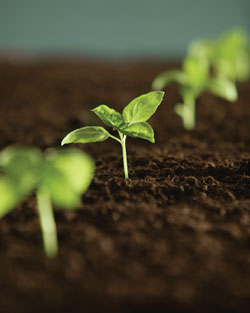The Green Scene
Fresh Start
Ruth Furman writer
 The drab days of winter are behind us and many of us are anxious to get growing. Meandering around the garden on one of those early spring days we are greeted with green fingers pointing towards the sun; it’s the daffodil bulbs we planted last autumn, and the forsythia buds are swelling. The signs tell us that at last it’s time to begin the process of sowing.
The drab days of winter are behind us and many of us are anxious to get growing. Meandering around the garden on one of those early spring days we are greeted with green fingers pointing towards the sun; it’s the daffodil bulbs we planted last autumn, and the forsythia buds are swelling. The signs tell us that at last it’s time to begin the process of sowing.
Since local food is fresh food, why not go a step further and grow local, right in your own back yard. Fear not. If you’ve been successful with annuals and perennials then vegetables will be as easy as plucking a tomato from the vine. Carve out a small corner of the garden that is open, gets plenty of sunshine, and is away from trees and shrubs, and you can supply your table from spring onwards. The most difficult decision is choosing what to grow: hybrid or heirloom, tried and true, or something new. I recall the first time we grew potatoes, fingerlings, in fact. Freshly dug from the garden and simply boiled, they were the best we ever tasted and we’ve never looked back. Whatever you choose to grow, the flavor will be far superior to something that has traveled 3,000 miles to your local supermarket.
Growing your own vegetables from seed is really quite simple, offers a greater selection, and gives you a jump start on the growing season. Get the whole family involved. Children love the magic of planting tiny seeds, watering them, and being rewarded by the emerging seedling. If this is your first venture with vegetables, start with the undemanding ones: lettuce, radishes, beets, tomatoes, peppers, and eggplants. The tomatoes, peppers, and eggplants need to be started indoors and, if you have the space, add some lettuce to the mix. Lettuce seedlings will take the cooler early-mid spring temperatures while the tomato, cucumber and eggplant seedlings should be set out when the soil has warmed and after danger of frost (usually the latter half of May around here). Most seed packets have reliable instructions for germination times and sowing particulars.
While growing your favorites is a great start, why not give your taste buds an adventure and try something unusual like kohlrabi with its mild cabbage flavor and beautiful purple or pale green tennis ball size bulbs? There’s also celeriac with its knobby bulbous root that’s a close relative of celery. Or, if you’re not up for that much adventure try a variation on the traditional types. Instead of orange carrots try a cultivar called ‘White Satin’ or the bite size ‘Thumbelina;’ once you try these you’ll never eat another supermarket baby carrot. If you like beets try ‘Touchstone Gold’ or the heirloom ‘Chioggia,’ a striking Italian variety with ornamental dark pink and white rings and a full flavor. For the many who grow zucchini, there’s a beautiful Italian heirloom with a sweet, nutty flavor called ‘Costata Romanesca;’ even the name sounds delicious. The heirloom runner bean ‘Painted Lady’ is a winner for its decorative beauty and abundance of bi-colored red and white flowers. It can look good anywhere in your garden and when you’re short a vegetable for dinner, just run out and harvest its pods. Success and a wonderful sense of accomplishment are at your fingertips. Take it slow and go sow!

